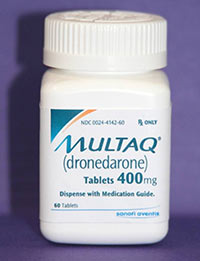Product
Multaq
Approval Date
July 2, 2009
Release Date
Summer 2009
Company
Sanofi-Aventis
Class
Anti-arrhythmic
Indication
For the treatment of atrial fibrillation (AF) or atrial flutter (AFL).
Active Ingredient
Dronedarone
Agency Roster
Euro RSCG Life 4D
Intouch Solutions, Inc.
Medicus LifeBrands
Physician Outlook
Multaq (dronedarone) is a promising new option in the treatment of atrial fibrillation/atrial flutter. While Multaq demonstrated morbidity and mortality reduction in treating these conditions, physicians’ uptake may be tempered by its a black-box warning based on potential fatal complications in patients with recent severe heart failure.
—Mary McBride, Associate Vice President, Research, GfK Healthcare
Also in the Pipeline (courtesy of Adis R&D Insight)
Drug: AprovelÂ
Manufacturer: Sanofi-Aventis/ Bristol-Myers Squibb
Indication: Diabetic nephropathies
Active ingredient: Irbesartan
Phase: Launched
Drug: EsapentÂ
Manufacturer: Pronova Biocare/ Ferrer
Indication: Hypertriglyceridaemia
Active ingredient: Omega-3 ethylester concentrate
Phase: Launched
Drug: KYNAPID
Manufacturer: Cardiome Pharma/ Astellas Pharma
Indication: Atrial fibrillation
Active ingredient: Vernakalant
Phase: Preregistration
Source: Wolters Kluwer Health
Recent MM&M Coverage
The Top 60: Medicus LifeBrands
Medicus NY
Bristol-Myers Squibb, Sanofi-Aventis win injunction in Plavix trial
The Top 40: Publicis Healthcare Communications Group
Pharmacology
Dronedarone is an antiarrhythmic drug that has properties belonging to all four types of antiarrhythmic agents (Classes I–IV).
Clinical Trials
In the ATHENA study, 4628 patients with AF/AFL and sinus rhythm were treated for up to 30 months with either the study drug or placebo, in addition to conventional therapy. The primary endpoint was the time to first hospitalization for cardiovascular reasons or death from any cause. Compared to placebo, dronedarone reduced the combined endpoint of cardiovascular hospitalization or death from any cause by 24.2%.
In two other studies, EURIDIS and ADONIS, 1237 outpatients with a prior episode of AF/AFL and who were in sinus rhythm were given either dronedarone or placebo, in combination with conventional therapy, and were followed for 12 months. Dronedarone delayed the time to first recurrence of AF/AFL, lowering the risk of first AF/AFL recurrence by about 25%, with an absolute difference in recurrence rate of about 11% at 12 months.
In the ANDROMEDA study, patients recently hospitalized with symptomatic heart failure (HF) and severe left ventricular systolic dysfunction were given either dronedarone or placebo. The primary composite endpoint was all-cause mortality or hospitalization for HF. This study was terminated early because of increased mortality in the dronedarone group, mostly due to worsening HF.
Adverse Reactions
GI upset, asthenia, rash, increased serum creatinine.
Adults
≥18yrs: 400mg twice daily (AM & PM) with meals.
Children
<18yrs: not recommended.
Contraindications
NYHA Class IV HF. NYHA Class II–III HF with recent decompensation requiring hospitalization or referral to a specialized HF clinic. 2nd- or 3rd-degree AV block or sick sinus syndrome, unless paced. Bradycardia (<50bpm). Concomitant strong CYP3A inhibitors (eg, ketoconazole, itraconazole, voriconazole, cyclosporine, telithromycin, clarithromycin, nefazodone, ritonavir). Concomitant agents that can cause QTc prolongation (eg, phenothiazines, tricyclics, certain oral macrolide antibiotics, Class I and III antiarrhythmics). QTc Bazett interval ≥500ms. PR interval >280ms. Severe hepatic impairment. Pregnancy (Cat.X) (use effective contraception). Nursing mothers.
Precautions
Consider suspending or discontinuing if worsening HF develops. Maintain normal serum K+ and Mg+ levels.
Interactions
See Contraindications. Avoid concomitant antiarrhythmics, CYP3A inducers (eg phenobarbital, carbamazepine, phenytoin, St. John’s wort), grapefruit juice. Reduce digoxin dose by 1/2, reevaluate and monitor. Reduce dose and monitor Ca+ channel blockers, β-blockers (bradycardia), other CYP2D6 substrates. Verapamil, diltiazem increase dronedarone levels. Dronedarone increases verapamil, diltiazem, nifedipine levels. May potentiate some statins, sirolimus, tacrolimus, other narrow-therapeutic range CYP3A substrates: adjust dose and monitor. Monitor other CYP3A or CYP2D6 substrates (eg, SSRIs).








